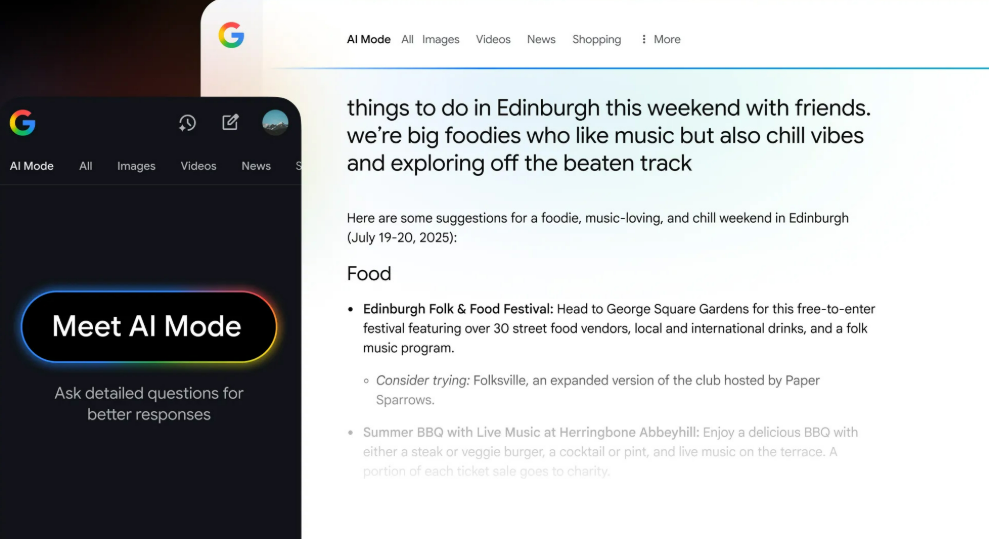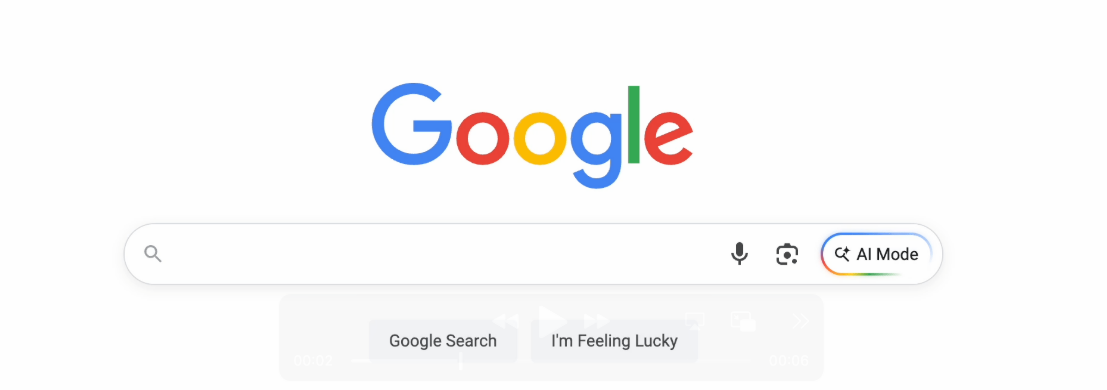Google quietly began rolling out AI Mode to the UK around midnight July 28; the process will continue over the next few weeks. This marks the most significant shift in Google’s search offering since the company’s inception, placing generative AI at the forefront of the search experience.
The impact for UK users and site owners alike will be significant, as has already been the case in the US and India.
In this article, we break down the key facts about AI Mode’s UK release — what it is, who can access it (and how), the impact it’s likely to have, and what businesses can do to stay ahead of the changes.
What is Google AI Mode?
AI Mode is a new LLM Google Search feature that trades in the usual SERPs (search engine results pages) for a full AI-generated results page tailored to the most specific intent of the searcher.
TDMP has been covering AI Mode developments in an earlier blog post. Get the background.

Source: Google
Powered by a custom Gemini 2.5 model, AI Mode is designed to better understand and respond to long, conversational queries — those that reflect how people naturally speak or think.
For example:
- Traditional search: "best budget hiking boots"
- AI Mode query: "What are the best hiking boots under £100 for beginners doing weekend trails in wet UK conditions?"
This longer-tail, conversational format gives Google more context to work with, allowing the AI to generate richer, more relevant answers without the user having to click through multiple links.
Google claims that they’ve ‘found that early users of AI Mode are asking questions that are two or three times the length of traditional search queries.’
This marks a shift from keyword-matching to true intent-matching, offering highly curated results that may combine:
- Generated overviews – similar to AI Overviews
- Carousels – showcasing products, destinations, or comparisons
- Multimedia embeds – videos, maps, or images surfaced contextually
- Contextual citations – source links backing up claims
- Follow-up field – creating a truly interactive search experience
To be clear, AI Mode isn’t replacing Google’s traditional search experience; their SERP with the classic ten blue links is still live — and will almost certainly stick around for a long time.
How will AI Mode impact UK websites?
Fundamentally, AI Mode will reduce organic web traffic to your website, intensifying the trend we’ve been observing since Google launched AI Overviews in the UK in 2024:
A recent Similarweb report shows that in the US, zero-click searches, where users find answers directly on the results page without clicking, jumped from 56% to 69% in the year following the launch of Google’s AI Overviews.
AI Mode does cite sources (an average of 12.6 per output). These are presented either in separate blocks (90.8%) or as inline text links (8.9%). But, with AI Mode able to give a large fraction of users what they’re looking for directly within its generated results page, fewer will click through to websites.
However, there’s some crucial nuance to consider.
AI Mode can only truly intercept traffic with shallow informational queries. Whenever someone is seeking products, services, or brands, they will of course go on a deeper search, clicking through to websites to assess offerings.
In short, low quality clicks are filtered out, while the clicks that matter are still happening — you just need to make sure your website is visible when these valuable clicks are up for grabs.
Optimising for visibility in AI Mode results is essential
With the arrival of AI Mode, optimisation strategies need to evolve. Unlike AI Overviews, which typically summarises content already ranking on the first page of traditional SERPs, AI Mode pulls from a broader range of sources, giving extra weight to contextual relevance.
This is due to their differing approaches to a process called query fan-out.
With query-fan-out, rather than treating a search as a single prompt, the AI breaks it into multiple sub-queries to cover different angles.
For example, a query like:
“Best UK broadband deals for remote workers in rural areas”
… could trigger sub-queries such as:
- “Broadband providers for rural UK”
- “Fastest internet for remote work”
- “Best value broadband packages UK”
The AI then distributes each mini query across the most relevant internal systems, including the Knowledge Graph, news indexes, and shopping databases, all at once. Finally, it retrieves the best-matching content for each sub-query and compiles the results into a single, AI-generated output.
Both AI Overviews and AI Mode use this fan-out process, but AI Mode applies it more expansively. Because it’s designed to support deeper, multi-turn queries, it generates a broader set of sub-queries — capturing more nuance and anticipating potential follow-ups, even if they weren’t part of the original prompt.
This deeper reasoning allows AI Mode to surface content that may not rank on the first page of traditional SERPs but is contextually the best fit for a specific part of the answer.
In short, your content doesn’t need to rank #1 to appear. It just needs to be the best fit for a specific piece of the puzzle. This means traditional SEO, while essential, is not the be-all-end-all solution for AI Mode visibility.
This is where recent signals from Google’s June 2025 core update become especially relevant. The update highlighted two major changes that support this AI-driven direction:
- E-E-A-T is rising in importance. Google reaffirmed that Experience, Expertise, Authoritativeness, and Trustworthiness are now more critical than ever. This is particularly true for distinguishing genuinely helpful content from manipulated or overly AI-generated material. Signals that detect user input and discount repetitive or mass-produced content are getting sharper. E-E-A-T now outweighs Page Experience in determining content quality.
- MUVERA and multi-vector retrieval are also shaping results. MUVERA improves how Google retrieves and ranks content by filtering out irrelevant or low-intent pages.
It enhances intent matching by analysing query nuance and aligning results with user behaviour — something that directly benefits the broader, context-heavy approach of AI Mode.
This suggests the bar is rising – and AI mode is going to be a highly competitive space. Building a presence here will require a specialised approach.
We’ve already covered AI optimisation in detail in a previous blog post, so we won’t get too technical here. But, in very general terms, you should ensure your content is:
- Deeply relevant to specific, long-tail or conversational queries
- Well-structured, with clear, factual, and easily extractable information
- Authoritative and trustworthy, ideally backed by citations or sources. E-E-A-T (Experience, Expertise, Authoritativeness, Trustworthiness) is still crucial!
- Semantically rich, using natural language and varied phrasing to match how people search
- Organised into synergistic topic clusters, as Google is looking for more than single-page relevance. You need to cover a variety of subtopics related to any of your primary subjects
Equally important, you need to track your presence and performance in AI Mode separately from standard search. As is the case with any form of optimisation, a measurable, data-backed approach is key to success.
Search Console currently doesn’t distinguish between user engagement happening on Google’s traditional SERPs, in AI Overviews, or in AI Mode — and it doesn’t look like this will change any time soon.
This means you need to explore alternative methods of monitoring visibility, estimating traffic impact, and attributing performance within AI search environments.
Looking to stay visible in AI-powered search?
At TDMP, we’ve been integrating AI search optimisation into our SEO strategies for years. We’ve also futureproofed our analytics approach to surface essential performance insights from AI search — so our clients are ready to benefit from, not just react to AI Mode. Get in touch to learn how we can do the same for you.
What does AI Mode mean for paid search?
While most of the focus around AI Mode has been on organic visibility, it also raises important questions for paid media.
As we’ll discuss in more detail later in this post, AI Mode is currently presented as a separate tab on the SERP. That’s encouraging for advertisers, as it means the paid ads that appear in traditional SERPs aren’t being pushed out of view — at least not yet. If AI Mode were to become the default search interface, ad visibility and click-through rates could take a hit.
That said, it’s hard to see how standard keyword-based campaigns, particularly those built around Exact and Phrase match types, will work effectively in AI Mode. The nature of AI-driven queries is longer, messier, and more exploratory — often straying far beyond the tight confines of traditional keyword targeting.
Why AI search changes paid media
AI Mode doesn’t just change how people search — it reshapes how intent is expressed.
In traditional search, high-intent moments are often tied to clear, commercial keywords like “buy,” “best,” or “near me.” But in AI Mode, users interact through longer, more exploratory prompts that look low-intent on the surface — yet carry strong purchase signals when seen in context.
Take this example of a generic user journey:
- “I’m struggling to keep up with multiple credit card payments”
→ AI explains options like balance transfers, consolidation loans, or budgeting tools. - “How do debt consolidation loans work?”
→ The user learns about how they reduce interest and streamline payments. - “Are there risks to consolidating debt with a personal loan?”
→ AI outlines pros, cons, and alternative strategies. - What should I look for in a good debt consolidation provider?”
→ AI highlights key features to compare
Individually, none of these would show up on your traditional lead gen keyword list. But together, they paint a picture of someone primed for conversion — a person who needs help, is exploring options, and is deep in the decision-making mindset.
AI Mode’s ability to interpret this journey in real time and match relevant information or ads accordingly could make future ad placements far more context-aware and conversion-ready than standard keyword targeting allows.
Campaign types that will thrive in AI Search
We expect the most effective paid strategies to shift toward AI-native campaign settings and types, especially:
- AI Max for Search
This newer campaign setting uses Google’s own AI to automate targeting, creative selection, and query matching — making it a strong match for how AI Mode interprets and responds to complex, intent-rich prompts. - Performance Max
Google has been steadily nudging advertisers in this direction for years. In a world where individual keywords matter less, Performance Max’s audience-first, asset-driven model fits neatly with AI-powered search behaviour.
Who can access AI Mode?
AI mode is gradually being made available to UK desktop users. It will show as an option for more and more people over the next few days.
Interestingly, Google has skipped the Search Labs testing phase for the UK launch — a step it included in both the US and India rollouts.
A mobile rollout is expected soon, but an Android app update will be required before AI Mode can be accessed on mobile devices. iOS support is likely to follow, though timelines haven’t been confirmed.
Google initially forecasted a late summer or early autumn release. Judging by the two-week testing period between initial and full launch in India, the former seems more likely for us.
Where is AI Mode?
The UK rollout is following the same pattern as the US, with AI Mode initially appearing as a separate search type tab (alongside ‘Images’, ‘Videos’, ‘News’, etc.). It will eventually be migrated to the main search interface.
This phased approach allows Google to test and refine the experience while minimising disruption to the broader search ecosystem.
Here’s what the AI Mode button looks like in the main search bar:

Source: Search Engine Roundtable
And here’s what it looked like as a search type tab:

Source: Search Engine Land
This may seem like a small detail, but the access point for AI Mode can have dramatic impact on use rate and general awareness.
As a search type tab, AI Mode is much less prominent. What’s more, since users have already initiated a search, their focus is typically on the results page.
As a button on the main search bar, AI Mode is highly visible, positioned to be the first touchpoint on a user’s search journey.
We can look to the US timeline to estimate when this transition might occur.
- March 5: Limited launch/testing phase
- May 20: Full US release for all users
- ~July 18: AI Mode button placed in Google search bar on main search page
That’s 135 days (or 4 months, 13 days) in total, and 59 days (or ~2 months, 3 days) from full release, which would place the UK button migration around mid-to-late September.
Although, realistically, with this being the third AI Mode launch, Google has no doubt refined their process and may be looking to expedite release stages — so we might see the AI Mode button in the main search bar sooner than the above dates suggest.
Is AI Mode available for all searches?
In its search type tab form, AI Mode only appears as an option for certain searches. These tend to be:
- Complex / multi-part requests
Example: “Which UK credit cards offer both cashback and airport lounge access?”
- Questions requiring planning or synthesis
Example: “How many litres of paint do I need to cover a 3-bed semi with two coats?”
- Open-ended or exploratory queries
Example: “What equipment do I need to start keeping bees in my back garden?”
- Follow-up enabled queries
Example: Initial: “Best beginner road bikes” → Follow-up: “How do I size a road bike frame?”
- Multimodal input or advanced reasoning
Example: Uploading a photo of a broken bike part via Google Lens: “What part is this, and where can I buy a replacement?”
Once the AI Mode button is added to the main search bar, users can choose to use it for any query. However, certain searches, such as well-known brand or website names, may still default to traditional SERPs, where direct links remain more appropriate.
Ready to adapt your strategy for AI Mode?
Google's search experience is changing fast. Brands that adapt early will be best placed to retain visibility, drive meaningful clicks, and stay ahead of competitors.
At TDMP, we’re already helping clients navigate this shift with AI-informed SEO strategies, enhanced analytics, and content planning built for the new rules of search.
Contact TDMP today for tailored advice and forward-thinking support.

